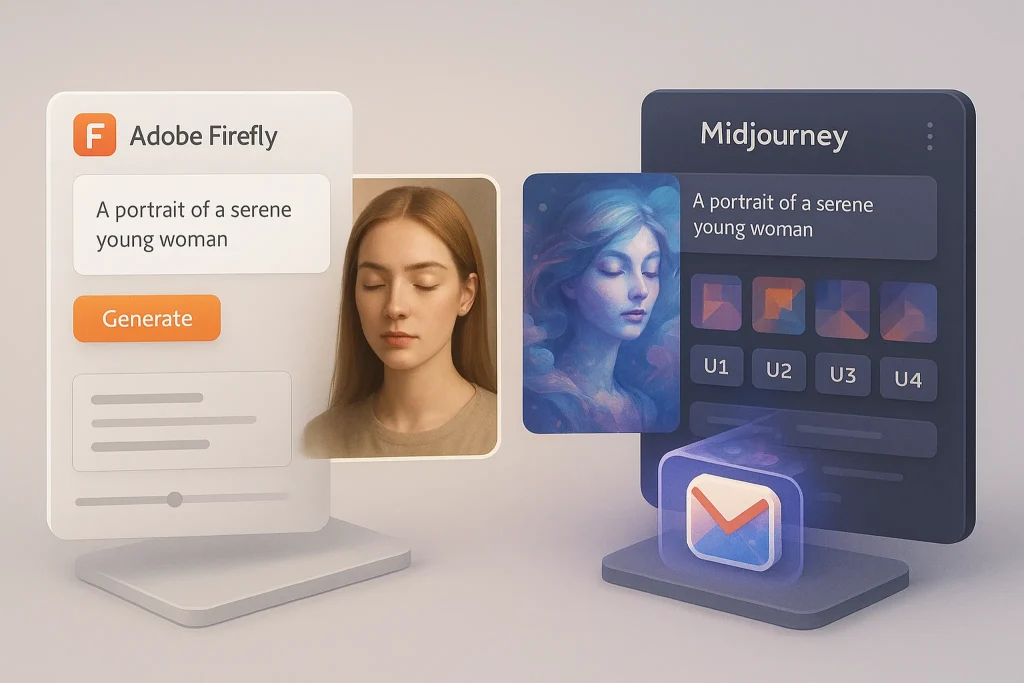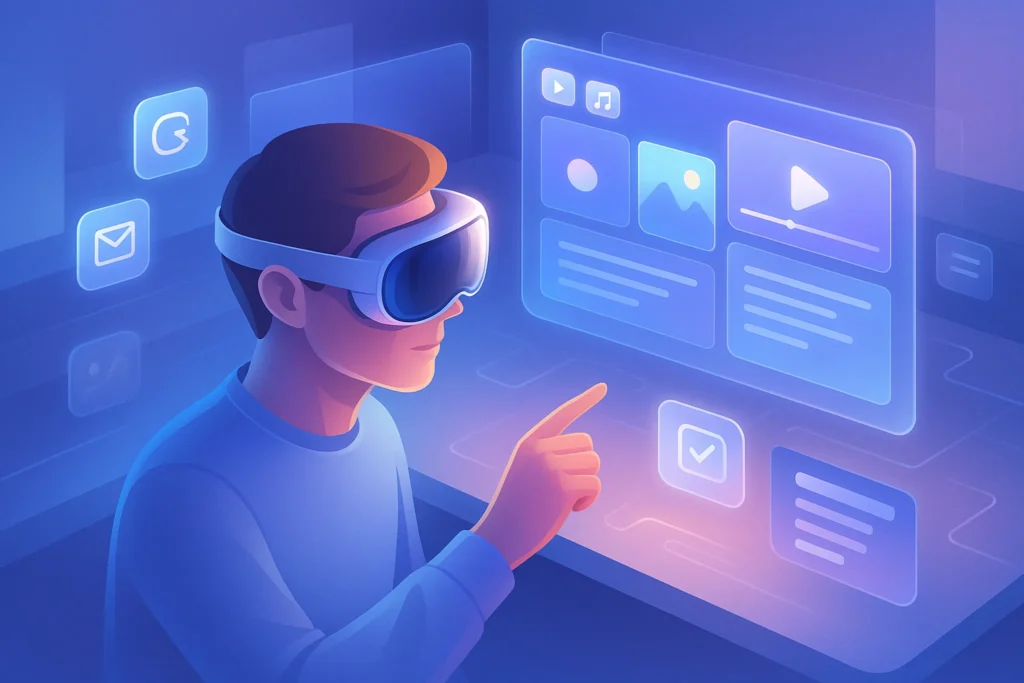-This post may contain affiliate links. If you click on one and make a purchase, I may earn a small commission at no extra cost to you.-
🎨 Introduction: Adobe Enters the AI Art War
In a world dominated by Midjourney, DALL·E, and Stable Diffusion, Adobe Firefly stepped in with a bold promise: AI image generation — made ethical, easy, and editable.
But how good is it really? And can it beat Midjourney in quality, creativity, and workflow?
This review dives deep into Adobe Firefly’s features, output quality, interface, and pricing, while putting it head-to-head with Midjourney.
AI art tools have exploded in the past two years. But in 2025, two names dominate the space: Adobe Firefly and Midjourney.
One promises tight integration with Creative Cloud and brand-safe results. The other? Limitless creativity and raw aesthetic power.
So which one should you use — whether you’re a freelancer, a social media marketer, or a pro designer?
Let’s compare them head-to-head in real-world use, output quality, and how well they fit into your workflow.
Let’s find out if Firefly is truly a game-changer — or just riding the AI hype wave.
While Firefly showcases Adobe’s growing investment in generative AI, it’s only one piece of a much larger ecosystem. If you’re curious how Firefly fits into Adobe’s broader creative suite—and whether Adobe Creative Cloud still offers the best value for creators in 2025—don’t miss our full Adobe Creative Cloud review. It explores how Adobe’s tools connect, evolve, and compete in today’s AI-driven landscape.
🔍 Overview: What They Are (and How They’re Different)
🔸 Adobe Firefly
-
Built by Adobe, Firefly is tightly integrated with Photoshop, Illustrator, and Express.
-
Trained on licensed and stock-safe data (no copyright drama).
-
Prioritizes brand-consistent and editable outputs (vector, layered PSDs).
🔸 Midjourney
-
A Discord-based image generator famous for surreal, detailed, and cinematic visuals.
-
Focused on raw creativity and high aesthetic fidelity.
-
No direct integration with design tools — purely visual outputs.
In short: Firefly plays safe and clean. Midjourney plays wild and free.
🚀 What Is Adobe Firefly?
Adobe Firefly is Adobe’s generative AI platform, launched as part of its Creative Cloud ecosystem. It allows users to generate:
-
Images from text prompts
-
Style variations of existing designs
-
Text effects, vector artwork, and content-aware fills
What makes Firefly unique is its focus on commercial safety — it’s trained on licensed Adobe Stock data, not scraped web content. That’s a big win for legal clarity in client work.
It’s also deeply integrated with tools like Photoshop, Illustrator, and Adobe Express — making it ideal for designers who want AI without leaving their creative flow.
✨ Key Features of Adobe Firefly
🔹 Text-to-Image Prompting
-
Intuitive prompt box with visual guide
-
Adjustable styles, aspect ratio, content type
🔹 In-App Photoshop Integration
-
Generative Fill (AI-powered content-aware fill)
-
Object addition and removal via text prompt
🔹 Commercial Use License
-
Safe for client work (Firefly is trained on Adobe-owned assets)
🔹 Style Customization
-
Ability to define and apply branded styles to generations
✅ Pros & Cons
✅ Pros
-
Beautiful UI and accessible interface
-
Tight Adobe ecosystem integration
-
Safe for commercial use
-
Real-time editing inside Photoshop
-
Great for branded content or campaigns
❌ Cons
-
Still evolving in output diversity
-
Limited aspect ratios compared to Midjourney
-
Requires Adobe account (no stand-alone API yet)
🧪 Comparison Table: Feature by Feature
| Feature | Adobe Firefly | Midjourney |
|---|---|---|
| Interface | Web-based, integrated into CC | Discord-based (text commands) |
| Output Control | High (edit layers, vectors) | Medium (prompt + style tuning) |
| Commercial Use | ✅ 100% safe (Adobe Stock-based) | ⚠️ Subject to ongoing legal grey zones |
| Output Style | Clean, minimal, brand-safe | Artistic, surreal, moody |
| File Format | PSD, SVG, JPEG | JPEG/PNG only |
| Ideal Use Case | Branding, UX/UI, product visuals | Moodboards, concept art, experimental |
| Learning Curve | Low (drag & drop, prompt assists) | Medium–High (prompt chaining, weights) |
| Price | Included in Adobe CC plans | Paid tiers (Fast GPU = $$$) |
🧠 Who Should Use Adobe Firefly?
Perfect for:
-
Graphic designers using Photoshop/Illustrator
-
Content creators needing legal image generation
-
Agencies building branded assets
-
Marketers creating visuals for ads and social media
Not ideal for:
-
Concept artists seeking surreal, high-detail renders
-
Users wanting deep prompt engineering flexibility
🧑🎨 Who Should Use What?
🔹 For Designers Creating Web & Brand Assets
👉 Firefly wins. You get editable outputs (like vector logos or text effects) ready to drop into Adobe Express or Illustrator.
🔹 For Creators Making Social Content or Concept Art
👉 Midjourney wins. Its outputs are bold, cinematic, and perfect for catching eyeballs on Instagram or thumbnails.
🔹 For Agencies Handling Corporate Clients
👉 Firefly is the safer bet. Licensing clarity, PSD layers, and CC compatibility mean fewer legal headaches.
🔹 For Freelancers Needing Creative Freedom
👉 Midjourney lets you build your own unique visual style. But you’ll need prompt mastery.
🎁 Bonus: Things Only Power Users Know
-
🔧 Firefly now supports vector recolor AI — perfect for brand palette generation.
-
🌌 Midjourney v7 adds “Stylize Range” for better control over prompt interpretation.
-
🧠 You can combine both tools: Generate raw art in Midjourney → Clean/edit in Firefly’s Photoshop Beta.
🎁 Bonus Tip: When to Use Each Tool
-
Use Firefly when you want brand-safe images & Adobe integration
-
Use Midjourney when you want jaw-dropping creative results
-
Combine both: draft in Midjourney, finish in Photoshop with Firefly
💵 Pricing Breakdown
-
Free plan: Limited daily generations
-
Included in most Adobe Creative Cloud subscriptions
-
No extra charge for Photoshop-integrated Firefly (as of 2025)
🛠 Alternatives to Adobe Firefly
🟣 Midjourney
Midjourney is one of the most popular AI art generators, known for its dreamlike, high-resolution, and often surreal visual output. It runs entirely through Discord, which can be a barrier for new users, but offers powerful prompt-based control for experienced creators. Midjourney excels at cinematic compositions, portrait realism, and creative edge, often used by artists, concept designers, and visual storytellers. However, it lacks native editing tools and doesn’t officially offer commercial safety guarantees, since its training data includes scraped web content.
The go-to for high-detail, expressive AI art. Steeper learning curve, but unmatched creative depth.
🟢 Canva AI Magic Studio
Canva’s AI Magic Studio is a user-friendly, all-in-one creative tool that adds text-to-image generation, background removal, auto-resizing, and smart layout suggestions — all powered by AI. It’s designed for non-designers, marketers, social media managers, and solopreneurs who want to create fast, polished visuals without touching Photoshop. While the image output isn’t as detailed as Midjourney’s or Adobe Firefly’s, Canva’s edge lies in speed, simplicity, and full brand kit integration. It’s especially useful for quick campaigns, presentations, and ad creatives.
Great for marketers and quick visuals. Very beginner-friendly.
🟠 Runway ML Gen-2
Runway ML Gen‑2 is the leader in AI video generation, but it also supports powerful text-to-image and image-to-image creation. What makes it stand out is its ability to generate moving visuals from static prompts, making it ideal for filmmakers, content creators, and digital artists exploring motion design. Its UI is modern and collaborative, and it integrates with creative pipelines via export options. If your project involves video content or visual storytelling, Runway ML offers tools that go beyond what static image generators can do.
Best for video generation, but also supports image creation.
If you’re already in Adobe’s ecosystem, Firefly is a no-brainer — it fits naturally into your workflow, saves time, and produces commercially safe results.
But if you’re chasing surreal, cinematic art? Midjourney still leads the way.
👉 Want to test them side-by-side? Start with Adobe Firefly’s free plan and see what fits your style.
🧠 Nerd Verdict: My Honest Take
“I use Firefly when I need clean, editable designs for clients — it’s safe and seamless.
But when I want something to blow my mind or pitch a bold concept, Midjourney is unmatched in visual poetry.”
If you value speed, integration, and safety → go Firefly.
If you want wow-factor, artistry, and mood → go Midjourney.
Many pros use both. You probably should too.
❓ FAQ: Nerds Ask, We Answer
Is Adobe Firefly better than Midjourney?
Depends on your goal. Firefly wins in workflow integration and legal safety. Midjourney wins in creative freedom and visual impact.
Can I use Firefly images commercially?
Yes — Adobe guarantees its Firefly images are commercially safe, thanks to its training on Adobe Stock.
Do I need Photoshop to use Firefly?
No, you can use Firefly via Adobe Express or the web — but Photoshop adds deeper editing tools.
Can I use AI-generated images in commercial work?
Yes, but only if the tool offers a clear commercial use license — like Adobe Firefly or Canva. Tools like Midjourney currently exist in a gray area due to training data concerns.
Which AI image generator is best for marketing and ad design?
For quick and branded visuals, Canva AI Magic Studio is ideal. If you need editable, professional-grade assets, Adobe Firefly is better. For artistic depth, go with Midjourney.
Can I use Midjourney for commercial work?
Technically yes, if you have a paid plan — but it’s not risk-free like Firefly.
Does Firefly require a Creative Cloud subscription?
Yes, though it has some free features in Express. For full use, you’ll need Photoshop/Illustrator.
Can I export layered PSD from Midjourney?
No. You only get flat images.
💬 Final Question
Which AI art tool do you prefer — Firefly or Midjourney?
And why? Let us know below or tag us on X. 👇



